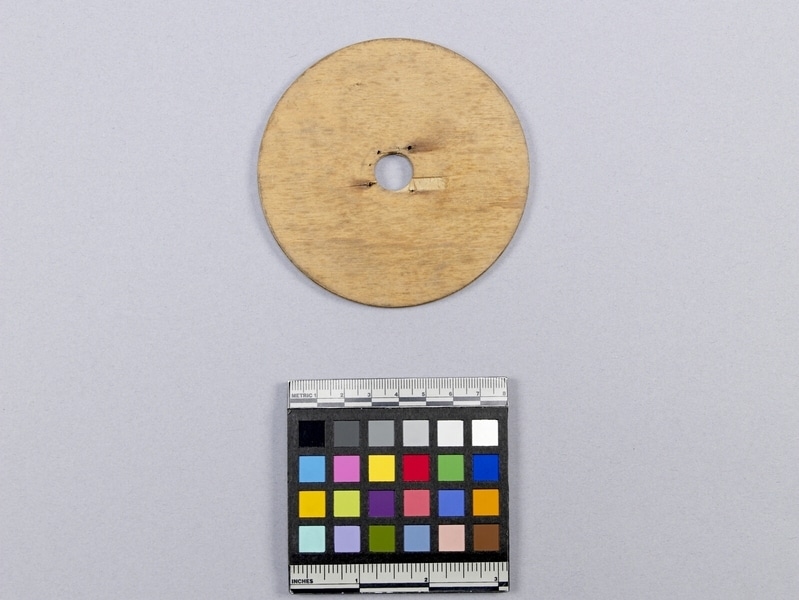Spindle Whorl Item Number: A4368 from the MOA: University of British Columbia


Description
Small, flat, disc-shaped spindle whorl with central hole. Made of laminated wood (three layers) with no surface decoration. Five small holes, stained black at their edges from contact with metal, surround the central hole. Yellow-brown in colour.
History Of Use
Spindle whorls are used in the spinning of wool. Anthropologist Homer Barnett (1955) notes that spindle whorls used by the southern Coast Salish of British Columbia are larger than those used in the north, with a shaft that is twice as long as the whorl. In the north, fibres were spun on smaller whorls that were "twirled between the leg and palm (1955:118)." By contrast, the larger whorls were used to spin fibres that were suspended from overhead. This arrangement created a tension in the roving. Johnson and Bernick (1986) report that traditionally several different techniques were used for turning the spindle. Contemporary weavers, however, now make use of a spinning machine that is similar in appearance to a treadle sewing machine. This spindle whorl is of the smaller variety, generally used in the north.
Cultural Context
weaving; recylcing; spinning
Item History
- Made in British Columbia, Canada before 1934
- Collected in Koksilah, British Columbia, Canada between 1893 and 1934
- Owned by George H. Raley before November 1948
- Received from H. R. MacMillan (Funding source) and George H. Raley (Seller) during November 1948
What
- Name
- Spindle Whorl
- Identification Number
- A4368
- Type of Item
- spindle whorl
- Material
- wood and adhesive
- Manufacturing Technique
- machine carved ?
- Overall
- height 0.3 cm, diameter 10.0 cm
Who
- Culture
- Coast Salish: Quwutsun'
- Previous Owner
- George H. Raley
- Received from
- H. R. MacMillan (Funding source) and George H. Raley (Seller)
Where
- Holding Institution
- MOA: University of British Columbia
- Made in
- British Columbia, Canada
- Collected in
- Koksilah, British Columbia, Canada
When
- Creation Date
- before 1934
- Collection Date
- between 1893 and 1934
- Ownership Date
- before November 1948
- Acquisition Date
- during November 1948
Other
- Condition
- fair
- Current Location
- Case 2
- Accession Number
- 1960/0429